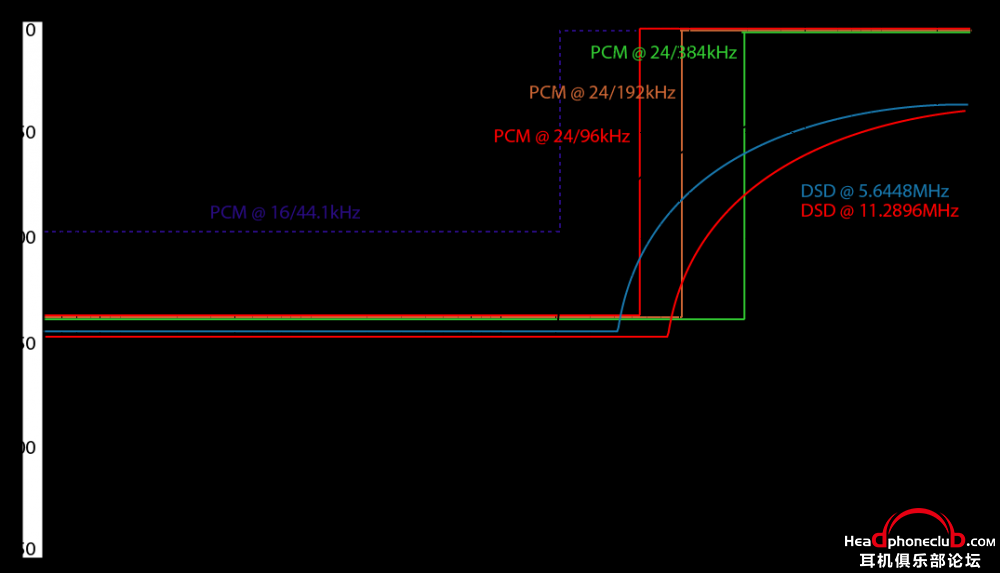感谢关注耳机俱乐部网站,注册后有更多权限。
您需要 登录 才可以下载或查看,没有账号?注册

x
开篇:木桶效应永远存在!在音乐重放领域,如何记录、如何编辑、如何封包、如何传播、如何打开封包、如何把信息源里的信号(放大)传输给播放设备等各个环节,都会影响最终传达到我们耳朵里的信息。 不过目前的状况是,大多数音乐爱好者只关注到了如何打开封包进行回放后端的环节,前面的如何记录、如何编辑、如何封包、如何传播对大多数音乐爱好者比较陌生。本人对这块一直比较感兴趣,最近也比较无聊,就云学习了一下,下面是一些体会,如果有不对的地方,欢迎大神们批评指正。 一、文件格式只代表封装方式,并不一定和音质划等号 爱好者们下载的资源常见的文件格式有flac、ape、wav、aac、dsf、dff、iso等等,不同的文件格式又有不同的采样率和码流,pcm从44.1 16到384 32等等,dsd这边从2.8到11.2等等,那么越高码率的文件是否一定代表更好的音质、更高的信息量? 我认为不是!我的看法是文件只代表了封装方式,并不一定越大的文件就真的越好音质。举个例子:一个300平方的房子不一定装的人就一定比100平方的房子的人多,文件格式只是代表了它音质的极限在哪里,并不代表音质实际水平。 目前比较尴尬的事情:很多资源是用电脑直接转换的文件格式,如mp3转的flac、wav转的dsd,这种通过转换文件格式来的资源相从文件本身来讲并没有什么卵用。
 不同文件格式动态范围和频段在格式上的天花板有区别,但不代表这个文件本身达到了这个指标!(麦克风的动态范围、AD设备、录音环境等等因素不可能不考虑,这里只是说文件格式本身的天花板)真正有意义的高清文件资源该是如何产生的呢? 以下引用著名dsd音乐网站“https://www.nativedsd.com/information/about-dsd”的定义NativeDSD, is our name, defining the objectives of this download service site. But, what exactly does that mean?
不同文件格式动态范围和频段在格式上的天花板有区别,但不代表这个文件本身达到了这个指标!(麦克风的动态范围、AD设备、录音环境等等因素不可能不考虑,这里只是说文件格式本身的天花板)真正有意义的高清文件资源该是如何产生的呢? 以下引用著名dsd音乐网站“https://www.nativedsd.com/information/about-dsd”的定义NativeDSD, is our name, defining the objectives of this download service site. But, what exactly does that mean?The word "Native" in NativeDSD Music means offering music files that are sourced as early in the production process as possible. The key word is Native. Unlike the majority of download service sites today, unless otherwise indicated, NativeDSD offers only DSD Edit Masters, sourced from DSD session recordings, and not ripped files from optical media. The much abused term “Studio Masters” has little relevance when the source of a sites download file is from the same optical media available to the consumer. To put this into perspective, this is most important for recordings that contain the fragile low level spatial and instrument detail content of acoustic recorded music. That is music recorded in an acoustic space at the highest technical level available, with the intent of transporting the music performance to the listeners’ room at the highest degree possible. Studio and Field Acoustic Recording Recordings can be grouped into those that are studio originated, and those that are field acoustic recorded. Acoustic recordings (which consist almost entirely of classical music and jazz recorded in a performance space), contain the low level information of instrument detail, spaciousness, and dynamic range, that allow the listener to best judge music image reality. Also, that which greatly enhances our emotional involvement. It is however those natural acoustic recordings that are most subject to sound quality degradation from the multiple processes inherent in production recording. For this reason,NativeDSD chooses its recordings from the earliest production stage possible. All DSD acoustic recordings start as musicians in an acoustic space being picked up with multiple microphones. The analog signals from these mics are first amplified by mic preamps, and fed to DSD Analog to Digital converters. Some labels will perform a session analog mix and balance before A/D conversion, but most labels, perform that mix and balance digitally in post production. In any case, post production always includes editing to correct note or tempo phrasing, and playing errors. Musicians and producers strive to present the best interpretation and performance possible. Post ProductionThe result of post production editing and mixing is a .dff DSD digital file called the DSD Edit Master, and which is the source of NativeDSD's downloads. From the Edit Master the DSD data is lossless compressed and encoded to produced a .dst ISO Cutting Master, which is then used by the SACD plant to produce an SACD for distribution. A similar process is used converting the DSD Edit Master for other optical media, like DVD-A and Blu-Ray, in their proprietary formats. There is however debate about whether the compression and encoding process for optical media production is in fact lossless from a sound quality standpoint. All download services have to obtain the file data they sell from the labels. With the exception of a very few house label download sites, and sites remastering original analog tapes, these files are supplied to the download services in optical media form (SACD, and to a lesser degree DVD-A, and Blu-Ray), and are then ripped. If the resulting DSD files are to be sold tagged with metadata, they use the track tagging contained in the ISO file. NativeDSD obtains the .dff DSD Edit Master files directly from the labels, converts them to .dsf (no music data conversion, just added data buckets to contain metadata). The .dsf files, both stereo and multi-channel are then custom metadata tagged with label supplied album data. The objective of this additional work is to provide the closest to the edited original project recording as possible, tagged with the most complete metadata available. 看得懂英文的朋友就不用多语了,对看不懂英文的朋友简单提及一下核心点:真正的高清文件应该是把包含各种细微信号录音原始素材进行重新采集编辑封装,而不是把售卖版的BD /CD等的文件数据读取出来再简单进行格式转换(RIP)。 二、现在的录音室怎么编辑制作高清格式音乐的? 我也是才知道目前的录音室里常用的软件有2种,一个是merging的 Pyramix 系统;一种是avid的Pro Tools系统。 我们先来看看pro tools的输入上限: 看到关键点了吗,它只能处理192KHZ 32位的,其实是无法完全覆盖dsd即使最低的2.8Mhz格式所需要的动态范围和信息区间的。因此,从纯理论层面讲,用pro tools的录音室做不出来真正极致的dsd。 再看看另外一家merging Pyramix对dsd的支持要好很多 它家又是DXD编辑方式的主导者 “Using DSD256 and DXD with Pyramix MassCore means that you can get all of the convenience of a digital workflow along with the impact of the analogue reproduction of DSD and DXD.” 从初浅层面看,pyramix这边有完整的dsd dxd录音 回放 编辑的解决方案,目前最高能支持到DSD256。 下面我们拿一些网站上的高清资源来初浅的看看高清资源是怎么制作的 这是一张sony高清网站上下载的挪威2L的录音,封面如上,也写明了录音时原始格式是DXD 录音时候的乐队排列 最后这页关键了,写明了录音时候的各种设备(主要就是merging那套horus+pyramix工作站) 国内的其实这部分也不甘落后,以北京创音为例: 有自己的音频接口 初浅的看了下,也是merging的方案为主。 有自己的典型案例“山西广播电视台是山西省委、省政府直属的正厅级建制事业单位,由省委宣传部领导,省广电局实施行政管理,实行党委领导下的台长负责制。在2015年,山西广播电视台重组资源,率先引进了DSD音频制作系统,用来把电视台的磁带、黑胶唱片等音乐资料数字归档,存储在电视台的媒体资源系统中,允许多个用户再次调用这些资料。技术台长介绍说,单位的黑胶唱片、节目磁带、都是经过几十年的累积而形成,这些资料很有历史意义,需要进行数字归档,同时要保留最佳音质。DSD音频系统很好的帮助我们解决了这个问题。” 国内的录音室软硬件水平也不甘人后啊。 三、如何鉴别高清资源 首先、靠谱的资源网站会给你提示原始录音和制作的信息 里面描述了原始录音的码流和设备等。 通过录音年代和原始录音信息,可以大致推测这个资源的高清水准。部份老录音是用开盘机AD转换来的。(这个只是纯硬件的猜测,不一定合理。其它因素:演奏水平、录音师水平、调音师水平等等都未考虑在内) 四、小结和建议 1、现阶段不必太过纠结高清文件的封装格式和文件大小 24 96以上的pcm和dsd64以上的文件格式就已经够高清了,再高的采样率对环境、演绎、录音、制作水平各个环节的要求甚高,也对我们回放设备的要求甚高。从木桶效应来讲,这样的文件格式已经不算短板了。 偶尔出现几张hiend级的高码率天碟,hiend级的回放器材可能才能发挥吧。 2、我们发烧友更应该关心自己的器材在什么封装格式 什么码率下发挥得更好 举个例子,比如我是briscati m1的用户,我可能更多会下载甚至转换高码率的pcm文件给我的系统(因为大家公认m1解码pcm时表现更好);比如我是meitner的用户,我可能会更多的下载甚至转换dsd文件给我的系统(因为大家公认meitner解码dsd时表现更好);再比如我是t+a dac8的用户,我可能更多时候会升频高码率的dsd文件给我的系统。。。 在这个时候,我们并没有通过改变音乐的封装格式获得了什么新的信息量,而是通过改变文件格式改变了我们回放器材解码端的工作状态,从而影响了最终传递到我们耳朵里面的声音。 本人水平有限,欢迎讨论斧正!
|  |联系我们|有害信息举报:010-60152166 邮箱:zx@jd-bbs.com|手机版|Archiver|黑名单|中国耳机爱好者俱乐部
( 京ICP备09075138号 )
|联系我们|有害信息举报:010-60152166 邮箱:zx@jd-bbs.com|手机版|Archiver|黑名单|中国耳机爱好者俱乐部
( 京ICP备09075138号 )